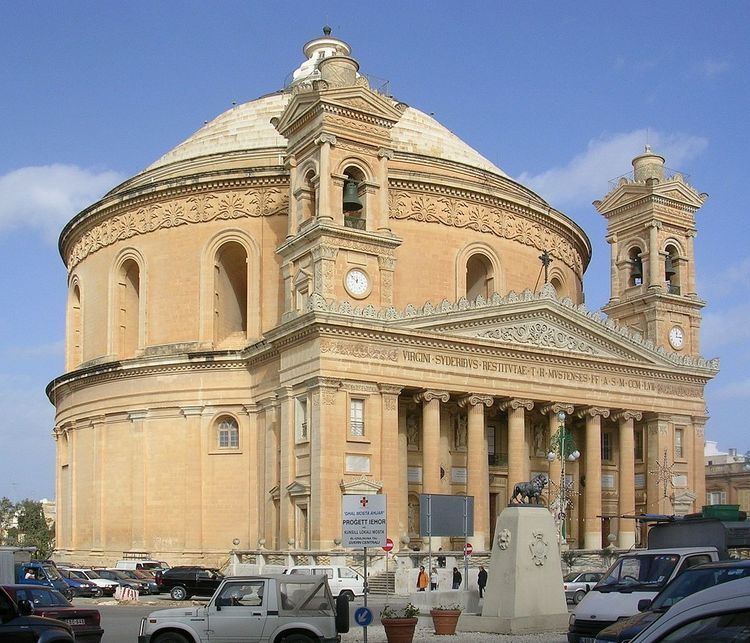Website mostachurch.com Opened 1865 Architectural style Neoclassical architecture | Denomination Roman Catholic Founded c. 1614 Dedicated 15 October 1871 Phone +356 2143 3826 Architect Girogio Grognet | |
 | ||
Similar St Paul's Cathedral - Mdina, Saint John's Co‑Cathedral, Ħaġar Qim, Rotunda of Xewkija, Mnajdra | ||
The Parish Church of the Assumption (Maltese: Knisja Arċipretali ta' Santa Marija), commonly known as the Rotunda of Mosta (Maltese: Ir-Rotunda tal-Mosta) or the Mosta Dome, is a Roman Catholic parish church in Mosta, Malta, dedicated to the Assumption of Mary. It was built between 1833 and the 1860s to neoclassical designs of Giorgio Grognet de Vassé, on the site of an earlier Renaissance church which had been built in around 1614 to designs of Tommaso Dingli.
Contents
The design of the present church is based on the Pantheon in Rome, and it is said to have the third largest unsupported dome in the world. The church narrowly avoided destruction during World War II, since on 9 April 1942 a German aerial bomb pierced the dome and fell into the church during mass but failed to explode. This event was interpreted by the Maltese as a miracle.
History
Although Pietro Dusina recorded Mosta as a parish in his 1575 pastoral visit, the town actually became a parish in 1608. Plans to construct a new church began soon afterwards, and the church was built in around 1614 to designs attributed to the Renaissance architect Tommaso Dingli. This church was commonly called Ta' Ziri.
By the 1830s, this church had become too small to cater for the town's population. Giorgio Grognet de Vassé proposed rebuilding the church on a neoclassical design based on the Pantheon in Rome. Despite opposition from Bishop Francesco Saverio Caruana, the design was approved and construction of the church began on 30 May 1833.
The new church was built around the old church, which remained in use throughout the course of construction. The residents of Mosta helped in building the church, taking part in construction work on Sundays and public holidays. Since Grognet had never received any formal architectural training, he received consultation services from an architect of the Sammut family.
The rotunda took 28 years to build, being completed in the early 1860s. The old church was demolished in 1860, and the new church did not need to be consecrated since the site had remained a place of worship throughout the course of construction. The church was officially dedicated on 15 October 1871.
During World War II, the town of Mosta was prone to aerial bombardment due to its proximity to the airfield at Ta' Qali. At about 16:40 on 9 April 1942, the Luftwaffe dropped three bombs on the church, and two of them deflected without exploding. However, one 500 kg high explosive bomb pierced the dome and entered the church, where a congregation of more than 300 people were awaiting early evening mass. The bomb did not explode, and a Royal Engineers Bomb Disposal unit defused it and dumped it into the sea off the west coast of Malta. This event was interpreted as a miracle by the inhabitants, and a similar bomb is now displayed in the sacristy at the back of the church, under the words Il-Miraklu tal-Bomba, 9 ta' April 1942 (meaning "The Bomb Miracle, 9 April 1942").
In 2015, the parish requested to the Vatican to be reclassified to the status of a basilica.
Architecture
The Rotunda of Mosta is built in the neoclassical style, and its structure is based on the Pantheon in Rome. Its façade has a portico with six Ionic columns, which is flanked by two bell towers. Being a rotunda, the church has a circular plan with walls about 9.1 m (30 ft) thick supporting a dome with an internal diameter of 37.2 m (122 ft). At one time, the dome was the third largest in the world. The church's interior contains eight niches, including a bay containing the main entrance and a deep apse with the main altar.
Before the church was constructed, there was some opposition to Grognet's design, since some regarded a Roman temple as an unsuitable model for a Catholic church building. However, others praised the design, and an 1839 book written while the church was being built describes it as "certainly the most magnificent, extensive and solid modern building" in Malta. This book further states that "when finished, [the church] will be an ornament to the Island, will immortalize the architect, and draw towards the casal every visitor to Malta." The design was well-received upon completion, and it is regarded as Grognet's masterpiece.
